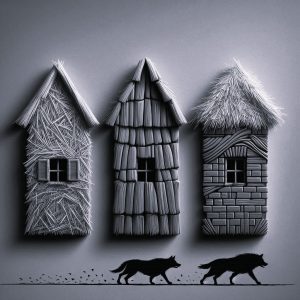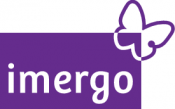The Folly of Flawed Foundations
Risk Principle(s):
Contingency Planning; Resilience Investment
Key Risk Lesson(s)
Cutting corners for speed can lead to vulnerability; upfront investment in strong foundations (e.g., cybersecurity, supplier diversity) is essential for withstanding crises.

In the unpredictable landscape of modern business, the true test of an organisation’s resilience isn’t whether challenges will arise, but how effectively it has prepared to withstand them. While agility and speed are often championed, the timeless wisdom embedded in the story of “The Three Little Pigs” serves as a fundamental primer on the non-negotiable value of robust contingency planning and strategic investment in resilience.
At Imergo, we consistently advocate for building durable foundations in an era of constant flux. This classic fable, understood since childhood, offers a crystal-clear metaphor for why cutting corners in preparedness inevitably leads to greater peril when external threats materialise.
Why investing in resilience protects you from the wolf at the door
The story unfolds with three siblings embarking on their independent lives, each choosing a different approach to building their homes. The first pig, prioritising speed and minimal effort, constructs his house from straw. The second, a step up in perceived effort, builds with sticks. Both homes are quick to erect, seemingly efficient, but fundamentally fragile. The third pig, however, foregoes immediate gratification, investing his time and energy in constructing a sturdy house of brick. When the big bad wolf—the external, relentless threat—arrives, only the thoughtfully constructed brick house withstands his repeated assaults. The first two homes crumble, leaving their inhabitants vulnerable and forcing them to seek refuge in the more resilient structure.
The risk lessons
This enduring tale powerfully illustrates that optimal and sustainable results arise from diligent contingency planning and a commitment to investing in resilience upfront, rather than prioritising short-term efficiency or cost-cutting. The “lean” approach of the first two pigs, while seemingly efficient in the initial construction phase, proved catastrophically vulnerable to foreseeable external pressures. In a business context, this translates to:
- Under-investing in critical infrastructure: Just as the straw and stick houses lacked structural integrity, organisations risk collapse when they under-invest in foundational elements like robust cybersecurity infrastructure, secure IT systems, or modern, compliant data management solutions. Saving costs in these areas creates systemic vulnerabilities that can be exploited by evolving cyber threats or operational failures, leading to data breaches, system outages, and significant financial and reputational damage.
- Over-reliance on single points of failure: The immediate simplicity of relying on single-source suppliers or streamlining operations by centralising all critical functions can create immense fragility. When that single supplier faces disruption, or that central function fails, the entire operational house can come tumbling down, much like the first two pigs’ homes. Effective risk management demands diversification, contingency suppliers, and distributed capabilities to absorb shocks.
- Neglecting business continuity and disaster recovery planning: The wolf will come, whether in the form of a natural disaster, a supply chain breakdown, a pandemic, or an economic downturn. Organisations that neglect to develop and regularly test robust business continuity and disaster recovery plans are building fair-weather operations. When the storm hits, they lack the frameworks and resources to recover swiftly, leading to prolonged downtime, loss of revenue, and potentially irreversible damage.
- The Illusion of speed over strength: The allure of quick market entry, rapid product launches, or immediate cost savings can often overshadow the need for thorough risk assessments, rigorous testing, and the establishment of resilient processes. The “straw house” strategy prioritises immediate output but leaves the organisation exposed to the “big bad wolf” of market shifts, quality failures, or regulatory scrutiny.
Building beyond the blow: Investing in enduring resilience
The simple wisdom of the Three Little Pigs serves as a profound call to action for modern leaders. It’s a vivid reminder that while immediate gains might seem appealing, true strategic advantage and long-term sustainability are built on a foundation of foresight, investment in resilience, and a deep understanding that threats are not hypothetical.
The wolf will come. The critical question for your organisation is: Have you built a structure that can genuinely withstand the storm, or one designed only for fair weather, leaving you vulnerable to every gust of change? By prioritising robust contingency planning, strategic investments, and a culture of resilient preparedness, you can ensure your organisation’s house stands strong, no matter how hard the wolf huffs and puffs.
If you would like to know more about how we can help you manage your risks contact us here.
